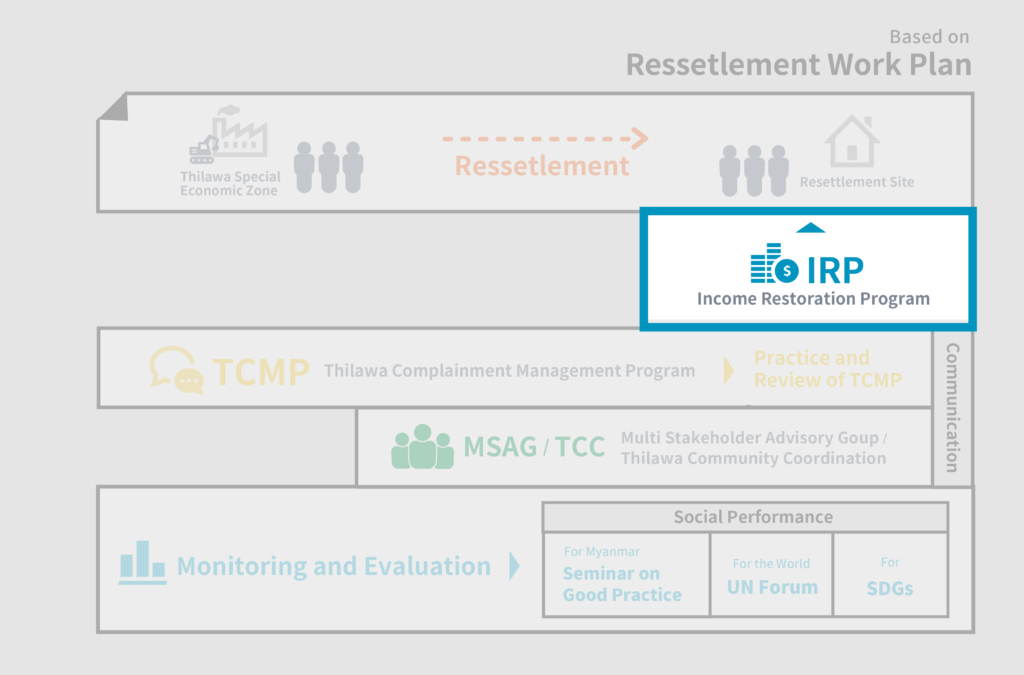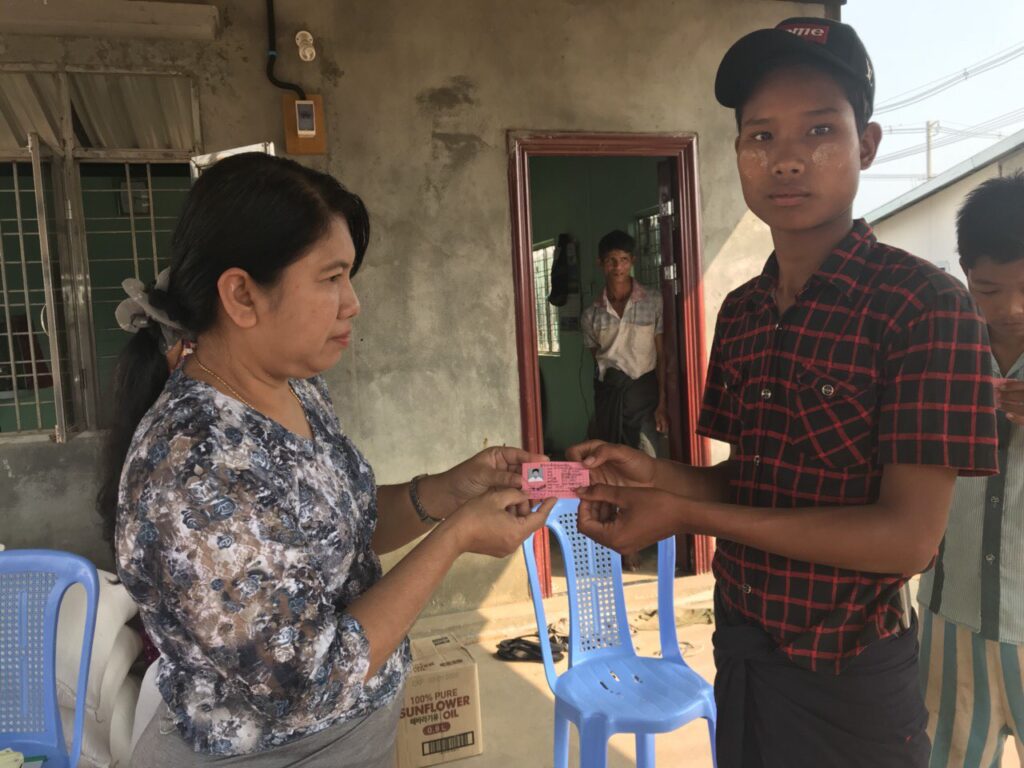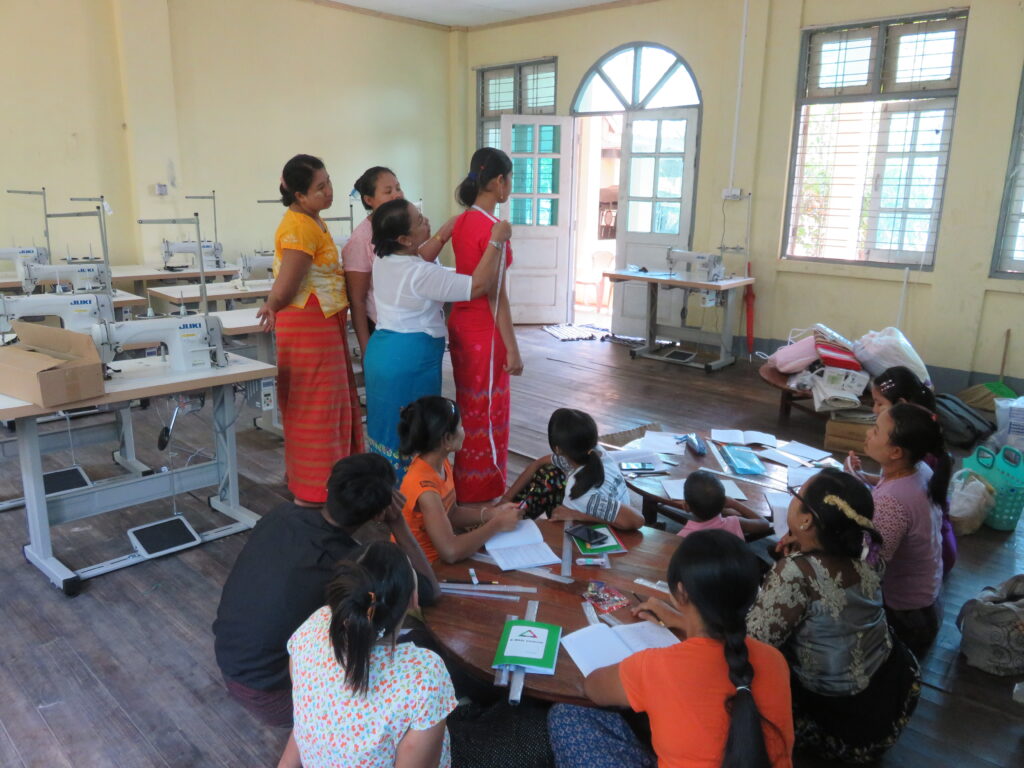
Concept and Background of IRP
The Income Restoration Program (IRP) is being provided as in-kind assistance to restore and stabilize the livelihood activities and income source of Project Affected Persons(PAPs). It supports the establishment of stable livelihoods for PAPs while taking advantage of the development of economic activity in the Thilawa Special Economic Zone(TSEZ).
The IRP consists of vocational training, technical advice and other support. In particular, it is oriented towards assisting PAPs to access job opportunities in and around the TSEZ as skilled labour and to be engaged in small businesses or employed in factories.
The IRP is available to all PAPs including:
(a) Farmers who need to alter their income earning activity from farming to another activity;
(b) Odd job (daily casual) workers and other off-farm workers who want to change their job place;
(c) Unemployed people who want to improve their technical skills to find employment; and
(d) Those who did not need to change their current income earning activities but want to improve their technical skills and income levels.
The IRP was designed to restore PAPs’ economic livelihood, and also considered social, physical, natural environmental conditions and human skill development as important factors to restore and sustain improved livelihoods.
PROGRESS OF IRP
Since June 2014, IRP activities have been undertaken on an ongoing basis including through a series of participatory workshops with PAPs, the Government of Myanmar (GoM), civil society organizations(CSOs) and resource people, to identify priority actions for livelihood restoration. In direct support of PAPs, the IRP will include the following activities
1.National Registration Card(NRC)
Overview
Without NRC, people were not able to transfer children to new school, to get a job, to open bank account, to travel around legally and to make other official procedures in daily life in Myanmar.
However, there are PAPs who did not possess NRC when the resettlement program was implemented. IRP supported to issue/reissue NRC for all PAPs during application of NRC and census retransferring from the Project Affected Area to resettlement site(RS) in collaboration with the Ministry of Labor, Immigration & Population, related Village Tract Administrators, Township General Administration Department and Township Immigration Department.
Zone A
Issued NRCs : 31 PAPs
Zone B
GoM supported 25 households during census transferring process application.
Reissued NRCs : 3 PAPs
Issued NRCs : 8 PAPs

2.Transferring School Children to a Nearby School
Overview
Concerning Project Affected Households(PAHs) who were relocated to the RS, children had to be transferred to a new school nearby RS with support of Thilawa SEZ Management Committee(TSMC) and the Ministry of Education.
Zone A
– 21 out of 23 children were transferred to new schools by June 2014. The balance of 2 children were not transferred because of family affairs. As of Aug 2016, 35 out of 38 children are attending school. The balance of 3 children were not transferred because of family affairs.
Zone B
– 16 children were transferred to a new school by May 2017 and 11 children were transferred to new schools by May 2018.
3.Vocational Training and Job Matching
3-1.Vocational Training
Vocational Training has been provided to PAPs to support those interested in securing employment at TSEZ or in another formally organized work environment. Vocational training is a key element to provide PAPs with the necessary skills that can enable them to be matched with a job at an employer, within TSEZ and/or nearby. Vocational training is normally directly provided by prospective employers or organized through a third party service provider, as relevant.
Zone A
PAPs participated in consultation meetings with local Civil Society Organizations (CSOs) to consider the type of training appropriate for identified future income generating activities. Local CSOs also conducted training needs surveys and assessed training proposals from PAPs.
Since the completion of the initial vocational training program (January -June 2014), PAPs have taken the lead in identifying the training required and proposing the training location. A daily allowance for attending training has also been provided.
In summary, the IRP provided a wide range of vocational training including: basic arithmetic training; driver training; security guard training; tailoring (sewing) training; language skill training (English, Japanese); computer skill training; and electricity installation.

Some training activities have been directly supported by Myanmar Japan Thilawa Development (MJTD) and also by the Japanese vocational training organization based at TSEZ: Fuji Work. They have included site visits to factories operating within TSEZ such as Cute Myanmar Thilawa Co., Ltd, which produces soft toys.
Zone B
IRP has provided a wide range of vocational training including a driving course and two tailoring courses to Zone B – Phase 1&2 PAPs. A driving training has been supported by TSMC, cooperated with the Central Institute of Transport and Communication in July, 2018. There were 14 participants who attended the driving training and they could get a driving license after the training in case they met criteria. Some participants could earn money by driving their relatives’ cars after attending the training.
In July, 2018, the first time basic and advanced tailoring training was organized by MJTD for Zone B – Phase 1&2 PAPs as one of TSEZ’s CSR activities. In April 2019, the second time basic and advanced tailoring training was organized as one of IRP activities in collaboration with the Ministry of Social Welfare, Relief and Resettlement. A professional sewing trainer from the Department of Social Welfare came to Kyauktan township to conduct a training to Zone B – Phase 1&2 PAPs and their relatives in the second time training. The total number of participants in the first and in the second time training were 13 each. TSMC lent each PAP with sewing machines after each training. Most participants could earn money by sewing at their homes or by working at garment factories at TSEZ or at local industrial zone near TSEZ or garment factories near TSEZ after attending these training sessions.
3-2.Job Matching Support
The IRP has supported PAPs to disseminate job vacancy information at TSEZ, to prepare Curriculum Vitaes (CVs) and has coordinated job interviews for them, working in close coordination with Myanmar Japan Thilawa Development Limited (MJTD), the developer of the Thilawa SEZ, the Yangon Regional Government (YRG), Investor, contractors and sub-contractors according to the following figure about the communication flow for job matching included in IRP action plan.
The IRP has been tracking the progress of PAPs that have expressed interest in working at the SEZ and those that have secured jobs.
Zone A
Following the development of the SEZ area, companies leasing space and construction companies working in the SEZ have started recruiting local workers to work in this area.
25 PAPs are working in SEZ as of the end of August, 2016.
16 people have applied for jobs in SEZ and are waiting for an interview which was held in Oct 2016.
Zone B
Factories under operation and construction companies have been recruiting local workers to work at the TSEZ.
36 PAPs are working and 41 PAPs have applied for jobs in TSEZ as of the end of June, 2019.
3-3.Site Tour at Thilawa SEZ
Since the TSEZ commenced operations in late 2015, a number of businesses have started activities. Site tours were organized for PAPs to learn more about the TSEZ development and the type of work likely to be available. 45 PAPs participated in this tour.
3-4.Job Readiness Training
The main purpose of job readiness training is to ensure that PAPs are prepared for wage labor, particularly in a context where many were either heavily engaged in cultivation/livestock production and/or casual labor. Job readiness training is provided to PAPs to support them in securing and maintaining employment. It is also designed to help participants develop good work habits that facilitate their ongoing success. It is provided either by a third party service provider or the prospective employer when the PAP is matched for employment.
Two days job readiness training were conducted to Zone B- Phase 1&2 PAPs by investors in TSEZ such as Alidac Healthcare Myanmar Co., Ltd and Foster Electric Co., Ltd in response to request from TSMC and Myanmar Japan Thilawa Development Limited (MJTD) in May, 2018. JICA Expert Team(JET) also supported this training technically by preparing necessary presentation materials and TSMC supported by giving daily allowances and transportation arrangement for participants to promote their participation.
The purposes of this training are to support PAPs to more easily find jobs which are suitable for them and to prepare for requirements before they start working. 23 numbers of participants attended the training in total. Curriculum included how to find suitable jobs, how to prepare CV, interview tips, good employee’s behavior and general rules and principles in factories.
| Lecture by Alidac Healthcare Myanmar Co.,Ltd | Participants in Job Readiness Training | Lecture by Foster Electronic Co.,Ltd |
4.Micro Finance Program
In March 2015, a community-based micro finance program commenced as an additional measure to support PAPs in developing stable livelihoods. A local microfinance program expert and local civil society group Shwe Hmaw Wun worked with PAPs to implement the program.
5.Infrastructure Improvement at the resettlement Site
Overview
The Thilawa SEZ Complaints Management Procedure (TCMP) allows stakeholders to raise questions or concerns with the TSEZ and have them addressed in a prompt and respectful manner. The TSEZ aims to address all complaints received, regardless of whether they stem from real or perceived issues.
There exist a few complaints from RS about infrastructure.Infrastructure improvement such as renovation of toilets and drainage has been done by IRP in order to solve the problem inside the compound of PAPs.
Zone A
In 2014, at the end of the rainy season, flooding and fresh water supply problems occurred in RS. In response, TSMC surveyed the ground level and condition of each house and collected information from residents about the drainage and other relevant details. The JET proposed a plan for technical infrastructure improvement at the RS. A series of workshops and meetings were conducted with residents. Based on their requirements and the survey results, three infrastructure improvement projects were identified: upgrading of houses; upgrading and cleaning of existing wells; and construction of a new culvert at the creek. In addition, four hand water pumps were upgraded and replaced.
| Upgrading and Cleaning of existing wells | Upgrading of houses | Construction of a new culvert at the creek |
Zone B
At the RS of Zone B – Phase 1&2, there was problem about overflow of wastewater from septic tanks depending on the number of persons who used toilets especially during the rainy season in 2017. In order to solve this issue, TSMC conducted investigations such as measuring ground level and discussing with residents several times. JET also supported TSMC to solve this issue. As a result of investigation, it was found that the groundwater level is higher in the rainy season and due to rain water flowing into the soil. This issue has been solved by installing an extra septic tank with an overflow pipe to drainage in each plot at the end of June, 2018 as per below.
Drainage
Another issue is that some drainage in RS was damaged due to heavy trucks. All damaged drainage was repaired in February, 2019 as shown below.
In June, 2019, resettlement site at Zone B – Phase 1&2 were flooded due to the fact that two drain from the RS to a nearby creek were blocked with the soil filled by the original land owner of the RS. Therefore this issue was solved by negotiation with land owner to remove the soil which blocked these drains. The problem of flooding to the relocated plots was solved by this method.
The Iron Removal Plant in the Water Supply System
Another issue occurred at the iron removal plant in the water supply system of RS of Zone B – Phase 1&2 due to the water quality of groundwater especially iron content for the water supply system. This problem was solved in the short term by cleaning the iron removal plant every month from April, 2018 to Nov, 2018 due to accumulation of sediment containing iron hydroxide in the iron removal plant. At the same time, water quality was been analyzed at the laboratory four times in 2018 to check the water quality of the water supply system.
Water Quality Problem
In order to solve this water quality problem in long term, JET proposed to dig a new tube well by investigating a new location to dig based on information about nearby aquifer such as depth of an aquifer, where a good quality of groundwater could be taken for water supply. After a series of discussions with Zone B – Phase 1&2 PAPs, a new tube well was dug at the depth less than the depth of existing tube well nearby the existing tube well in Jan, 2019. When the water quality from the new tube well was tested at a laboratory, it was found that the amount of iron content in the new tube well is less than that in the existing tube well and the water quality was good enough for using. Therefore, the new tube well is used for water supply system for the RS of Zone B – Phase 1&2.
| Existing Tube Well | Water from the existing Tube Well |
6.Social Welfare Support Program
Following the findings of the first external monitoring and evaluation review in late 2014, a transitional allowance for PAPs was proposed, as an additional measure of support for PAPs in restoring their livelihoods. The supplementary program was named the Social Welfare Support Program (SWSP).
Transitional allowances are common in land acquisition and resettlement programs. Such allowances are generally separate from compensation. They are supplementary ‘support measures’ – provided in cash or as in-kind support – and are consistent with international good practice. In the case of the IRP, payments were provided to bank accounts, not directly in cash.
・The SWSP concept was discussed and designed with the input of civil society representatives and local trusted persons including religious leaders.
・Support for all PAPs to Establish Bank Accounts.
・Technical training for family account management has been implemented consistently since March 2015 to support PAPs in managing household finances.
・Monitoring surveys and day-to-day observations have been conducted to assess how PAPs have used the SWSP to restore their livelihoods and reduce any debt.
6-1.Vulnerable People Program
Vulnerable or at-risk displaced people require additional livelihood assistance to restore their livelihoods to at least pre-project levels. Therefore IRP gives the first priority to vulnerable people to give additional livelihood support. Vulnerable People Program has been provided to vulnerable PAPs/PAHs in addition to the entitlements under the Resettlement Work Plan(RWP). These measures are designed to assist vulnerable PAPs to successfully participate in livelihood restoration activities.
In other words, Vulnerable People Program is a key element of the component of IRP: support for restoration of economic conditions through a combination of activities for enhancement of income earning opportunities and household account management. As shown in the following figure, the Vulnerable People Program in IRP comprises the following steps.
- STEP1; Additional Basic Living Provisions;
- STEP2; Choosing an IRP Stream;
- STEP3; Intensive IRP Support
All assistance under the Vulnerable People Program has been provided at the household level (e.g., to vulnerable people and their families). It is a critical point for local government including Village Tract/Ward and Township related departments and authorities to be involved in development of the specific activities to be implemented under the Vulnerable People Program.
Basic living provisions
Vulnerable People/Households in Zone B – Phase 1&2 have been provided with basic living provisions since March 2018 to until. Criteria to identify Vulnerable People has been decided through a series of consultations in Zone B – Phase 1&2, local authority and PAPs based on the IRP Action Plan and Resettlement Work Plan. As of June 2019, there are 23 vulnerable households and they have been provided with basic living provisions every month by TSMC.
At the same time, TSMC conducted the quarterly monitoring survey to vulnerable households since September 2018 to monitor livelihood of vulnerable households and four monitoring were done until June 2019.
| In June, 2019 | In Dec, 2018 | In Dec, 2018 |
There has been a social welfare program to support relocated Zone B – Phase 1&2 PAPs with cash assistance; when there is a baby born, a funeral, an accident or a serious illness has happened in their family since April, 2019.
6-2.Secure Ownership of the Land Property
IRP protects ownership of the land property at the RS for PAHs.
ZONE A
63 out of 68 Households from Zone A RS were provided land permits in July 2018.
ZONE B
All 91 relocated households from Zone B were provided land permits in March 2019.
TSMC held the land permits for relocated land giving a ceremony for all 91 relocated households from Zone B – Phase 1&2 in March 2019 as their land property.
